


Notice: This is the official website of the All Empires History Community (Reg. 10 Feb 2002)
Describe a Battle |
Post Reply 
|
Page 12> |
| Author | ||||||||||||||||||||||||||||
Lannes 
Baron 

Retired AE Moderator Joined: 02-Aug-2004 Location: United States Online Status: Offline Posts: 439 |
 Quote Quote  Reply Reply
 Topic: Describe a Battle Topic: Describe a BattlePosted: 12-Aug-2004 at 16:50 |
|||||||||||||||||||||||||||
|
I thought giving members a chance to give descriptions of some of their favorite battles would be a good way for others to get a good general idea of what went on in the battle. It would also most likely give users a scope into how battles were fought in whatever time period your battle description is from.
|
||||||||||||||||||||||||||||
|
τρέφεται δέ, ὤ Σώκρατης, ψυχὴ τίνι;
|
||||||||||||||||||||||||||||
 |
||||||||||||||||||||||||||||
Quetzalcoatl 
General 
Suspended Joined: 05-Aug-2004 Online Status: Offline Posts: 984 |
 Quote Quote  Reply Reply
 Posted: 14-Aug-2004 at 21:55 Posted: 14-Aug-2004 at 21:55 |
|||||||||||||||||||||||||||
|
It's biased because it is written by the English but it give you a good idea. Battle: FONTENOY
Place: East of the Scheldt opposite Tournai around the villages of Fontenoy, Vezin and St Anthoine in South West Belgium. British Regiments: Fontenoy is not a battle honour for British regiments. Account: Marshall Saxe doubted whether French troops could stand against English and Austrians in open battle. He prepared a position in the hills to the east of the Scheldt comprising a triangle of fortified points behind which the French army would be shielded. Two of these redoubts were in the villages of St Anthoine and Fontenoy at the top of a sloping incline. The third was on the edge of a wood and called the Redoute D�Eu.
The Pragmatic Army approached the base of the incline through Vezin and other villages, that had been set ablaze by French skirmishers. It was apparent that the French were occupying St Anthoine and Fontenoy but the whereabouts of the rest of the French army was uncertain.
English cavalry ventured onto the incline and came under cannon fire. General Campbell, the lieutenant general of the horse, was killed and the cavalry withdrew to take no further part in the battle. Brigadier Ingoldby was deputed to take the Redoute D�Eu before the columns attacked, but he prevaricated and called for artillery. Ingoldby was no doubt daunted at the prospect of assaulting the redoubt with foot alone. In spite of increasingly peevish directions from His Royal Highness, Ingoldby failed to move. Finally Ligonier�s two columns were ordered to advance even though both fortified positions remained intact, one on each flank subjecting the columns to damaging cannon fire. The two English columns of foot reached the top of the incline and found the whole French army arrayed before them on the plateau. The English Foot were then attacked by waves of infantry, horse and dragoons. Only when the attack was made by fresh regiments of Irish Foot in the service of France did the columns finally give way and retreat back down the incline, ending the battle. In the meantime the Highland Regiment had committed itself to frenzied but unsuccessful attacks on Fontenoy. |
||||||||||||||||||||||||||||
 |
||||||||||||||||||||||||||||
Quetzalcoatl 
General 
Suspended Joined: 05-Aug-2004 Online Status: Offline Posts: 984 |
 Quote Quote  Reply Reply
 Posted: 14-Aug-2004 at 21:58 Posted: 14-Aug-2004 at 21:58 |
|||||||||||||||||||||||||||
Dresden26-27 August, 1813 The Napoleonic Guide's Suggested Tours Following the battles of Lutzen and Bautzen, Napoleon Bonaparte - needing to reorganise and resupply his armies - accepted a 10-week truce from the Allies. The decision was a poor one as the Allied powers - Austria, Russia and Prussia - had more available manpower and finished the truce period far stronger than they had been. The French now found themselves facing an enemy of well over 400,000 men. In the north, former marshal Jean-Baptiste Bernadotte had 100,000 troops, Field Marshal Gebhard Blucher commanded a similar size army in the south-east and General Schwarzenberg had 240,000 men approaching from the south. One of the key cities for the campaign was Dresden - the capital of Saxony - and now the opposing forces moved to occupy it first. As it happened, Marshal Gouvion St Cyr and a corps of 20,000 got there before the other forces. The marshal found the city was poorly fortified and the French worked feverishly to improve the position. Within a day, however, the defences were to be tested by some 160,000 enemy troops. At dawn on 26 August, Schwarzenberg sent his army against St Cyr's men but, fortunately for the French, the attacks were poorly coordinated and were not pressed home to take advantage of the seven-to-one odds. The French fought hard and gave ground reluctantly. With casualties mounting quickly, the Allies hesitated and during the lull in fighting Bonaparte arrived at the head of more than 50,000 men. Confusion now swept the Allied high command and while it decided to withdraw - the policy being not to take on the French emperor himself - the field commanders sent in another series of attacks against Dresden. After a solid day's fighting, St Cyr's exhausted men found the renewed Allies push too much to withstand and they fell back from key positions. However, Bonaparte was on hand and sent his fresh Imperial Guard on to the attack. Within five hours, they had retaken all the positions lost during the day of fighting. With reinforcements arriving throughout the stormy night, dawn saw Bonaparte with up to some 150,000 to send against the Allies. Pinning them in the centre, the French emperor then threw considerable forces, some 35,000 men, against each Allied wing. On the Allied right, Marshal Mortier smashed through and turned the flank, while at the other end of the enemy line Marshal Murat was even more damaging - killing, capturing or routing 24,000 enemy troops. Nightfall saw the Allies decide to withdraw, leaving behind some 40,000 casualties - including General Jean Moreau who was killed by a cannonball. The French suffered some 10,000 dead and injured. |
||||||||||||||||||||||||||||
 |
||||||||||||||||||||||||||||
Guests 
Guest 
|
 Quote Quote  Reply Reply
 Posted: 15-Aug-2004 at 15:11 Posted: 15-Aug-2004 at 15:11 |
|||||||||||||||||||||||||||
|
CHANCELLORSVILLE The Beginning
Edited by King Jeff 2 |
||||||||||||||||||||||||||||
 |
||||||||||||||||||||||||||||
ihsan 
General 
Retired AE Moderator Joined: 06-Aug-2004 Location: Turkey Online Status: Offline Posts: 831 |
 Quote Quote  Reply Reply
 Posted: 15-Aug-2004 at 18:24 Posted: 15-Aug-2004 at 18:24 |
|||||||||||||||||||||||||||
|
Hmm, perhaps I can describe a few battles from the early Ottoman era...
|
||||||||||||||||||||||||||||
 |
||||||||||||||||||||||||||||
demon 
Chieftain 

Joined: 03-Aug-2004 Location: Brazil Online Status: Offline Posts: 1185 |
 Quote Quote  Reply Reply
 Posted: 21-Aug-2004 at 14:19 Posted: 21-Aug-2004 at 14:19 |
|||||||||||||||||||||||||||
|
Battle of Myong Riang straight
Year: 1597 Date: September 16 Background: 100,000 Japanese marines in around 200 ships lead by Gurushima Michihoosa were sent from Japan destined to Seoul. Yi Sun shin, whose fleet were composed of only 12 ships, no turtle ships, decided to crush the army once for all- at a straight by the name Myong Riang(Myong Lan). Place: Myong Riang was a narrow straight(average of 500m wide). Its narrowest place has width of only 300m. However, both sides of that place is covered by sharp coastal rocks, leaving only about 130m width for a ship to sail safely. In addition, its narrow features allowed water currents to go as fast as 11 knots. Anterior Events -July 15th- When Yee was in trial, Yee's substitute lead his navy, which was destroyed almost completely by the Japnaese. Only 12 ships survived. No turtle ships survived. -September 9th- While Yee got innocent from trial and tried to regroup his men, Japanese spies confirm that Yee had only 12 ships. -September 16(Date of Myong Riang battle)- Japanese Advance! 133 Elite Royal Navy followed by a second wave of 70 ships. Plot: Japanese general was too cocky and had his pride blinding his sight. He knew that his 133 Elite navy would destroy merely 12 ships. The time was around 12:00 morning. They were moving at counter current. So he Charged straightly for the straight. He was thinking of surrounding Korean navy with the T cross, but he realized that the straight was too narrow and the ships on the side were getting trapped on the sharp boulders, so the ships had to pass one by one. When the ships on the front were coming out, they saw Koreans ships turn, and shoot their missiles. Infantry from the deck of the ship were also launching arrows. The ships were not on the position of retreat because other japanese ships followed behind. They were trapped between hell and hell. By 1 hr, 20 Japanese ships were sunk. After 20 of the first wave ships were sunk, the Koreans witnessed the Japanese General, whose ship had feathers on the flag tip, red all over. Yi ordered one of his comarades to send 3 ships on offensive. They surrounded the ship, and unleashed hell. They saw one reddish guy with silk clothes fall. He was Michihoosa, dead. His neck was soon stuck in a Korean pike, so that All Japanese could see. Now the time turned to around 3:00. The water current was reversing, with faster current. Yi issued the rest of 9 ships to join the carnage. THe Japanese ships now were turning their heads. But the water current was sucking them into the Koreans. The Japanese ships clashed with the ones behind. Some were driven to the sides, into the sharp rocks. THe current reached 11 knots. Ships that dreamed of an escape were driven back to the straight, into the rocks. Around 100 ships were sunk. Corpses everywhere. A true bloody sea. Only those ships waiting on second wave managed to run back, they who also suffered damage from currents and spontaneous Korean rockets. Battle was over. This defeat forced Japanese forces to return to their bases. Casualties: Korea: ship=none, Men- like 30 Japan: ship=133, Men- Uncountable Winner: Korea  Myong Riang  Missiles used by Koreans in this battle. |
||||||||||||||||||||||||||||
|
Grrr..
|
||||||||||||||||||||||||||||
 |
||||||||||||||||||||||||||||
Jagatai Khan 
Chieftain 

Jeune Turc Joined: 07-Aug-2004 Location: Turkey Online Status: Offline Posts: 1270 |
 Quote Quote  Reply Reply
 Posted: 07-Sep-2004 at 06:21 Posted: 07-Sep-2004 at 06:21 |
|||||||||||||||||||||||||||
|
Is this Manisa??? |
||||||||||||||||||||||||||||
 |
||||||||||||||||||||||||||||
Lannes 
Baron 

Retired AE Moderator Joined: 02-Aug-2004 Location: United States Online Status: Offline Posts: 439 |
 Quote Quote  Reply Reply
 Posted: 07-Sep-2004 at 17:28 Posted: 07-Sep-2004 at 17:28 |
|||||||||||||||||||||||||||
Yep, Manisa is the modern day name for the city. |
||||||||||||||||||||||||||||
|
τρέφεται δέ, ὤ Σώκρατης, ψυχὴ τίνι;
|
||||||||||||||||||||||||||||
 |
||||||||||||||||||||||||||||
Tiamatty 
Immortal Guard 
Joined: 26-May-2005 Online Status: Offline Posts: 0 |
 Quote Quote  Reply Reply
 Posted: 26-May-2005 at 09:38 Posted: 26-May-2005 at 09:38 |
|||||||||||||||||||||||||||
|
The Battle of Chibi (208 CE, southern China, possibly just north of Wulin) Also known as the Battle of Red Cliffs. Fought between the forces of Cao Cao against the combined forces of Sun Quan and Liu Bei. Cao Cao had a supposed army of 830, 000, though it was probably closer to 200, 000. Sun Quan and Liu Bei had a combined army of 50, 000. In charge of the combined forces was Zhou Yu, vassal of Sun Quan. Cao Cao had conquered northern China, and begun marching his army south. He easily took the Jing province from the heir of Liu Biao, and was ready to attack Sun Quan's territory (later to be called the state/kingdom of Wu). Sun Quan was unsure of what to do, as his army was much smaller than Cao Cao, but decided to fight on the advice of his chief advisors, Zhou Yu and Lu Su, as well as Liu Bei's advisor Zhuge Liang. The forces were arrayed opposite each other on the Yangtze, with Cao Cao stationed at Jiangling. Cao Cao's forces were mostly from the north, so were unused to naval battles. He'd managed to hire a couple of experienced naval commanders in Jing, so he had them train his forces. At the same time, he sent a spy to Zhou Yu's camp. Zhou Yu saw through the spy, but decided to use the guy to his advantage. He held a banquet, where he got drunk, and invited the spy back to his own tent. He had left a couple of fake letters, supposedly from the naval commanders in Cao Cao's army, saying they wanted to defect. The spy thought they were real, and relayed the information back to Cao Cao, who then executed the supposed traitors. Zhou Yu then took a boat, covered it in straw, and sailed near Cao's fleet. Cao ordered arrows be fired at the boat. The arrows stuck into the straw, and when Zhou Yu returned to his own camp, it was with many of Cao Cao's arrows - one of the best tactics ever, in my opinion. Cao Cao then sent a couple more spies as supposed traitors. Zhou Yu whipped one of his top generals, Huang Gai, in front of the other Wu generals, and the spies. The spies sent word of what they saw, and Huang Gai sent a letter of defection to Cao Cao. Meanwhile, Cao Cao had chained his ships together to steady them, and thus reduce seasickness in his northern troops. Cao Cao's army was also suffering from various diseases that the southerners had gotten used to over the years, but which the northeners had never come across, making his army still less effective than it could've been. Eventually, the day came for the attack. Cao Cao advanced his fleet, but found a south-east wind kept him from advancing well, as well as making arrows less effective. He called for a retreat, but since the ships were trained together, an orderly retreat was impossible. To make it worse, Huang Gai's defection was faked - it was only a ploy to get a ship near Cao Cao's fleet. The ship was full of straw, and when Huang Gai's ship neared, the straw was lit on fire. With the south-east wind, the fire ship swiftly rammed right into Cao Cao's fleet, and the wind made the flame even more effective, spreading it throughout Cao's fleet. Zhou Yu followed this up with an all-out attack, decimating Cao's forces, and ambushes set up in advance by Zhuge Liang kept Cao from being able to rally his remaining troops for a counter-attack. Thus proving that size doesn't always matter. Quality beats quantity; a superior strategy can destroy an army of any size. |
||||||||||||||||||||||||||||
 |
||||||||||||||||||||||||||||
Mosquito 
Caliph 

Suspended Joined: 05-Aug-2004 Location: Sarmatia Online Status: Offline Posts: 2537 |
 Quote Quote  Reply Reply
 Posted: 26-May-2005 at 16:31 Posted: 26-May-2005 at 16:31 |
|||||||||||||||||||||||||||
|
The battle of Kirkholm 1605.Sweden vs Poland-Lithuania The swedes: about 8500 infantry and 2500 cavalry (some sources say Swedes had over 3000 cavalry) and 11 guns. But i saw also books which were saying that Swedes had 6000 infantry and 5000 cavalry.Poles and Lithuanians: about 3500 soldiers including 1000 infantry, 3 canons,Swedish commander: king Karl IXPolish-Lithuanian commander: hetman John Charles ChodkiewiczPlace: Kirholm, near RigaNote: different sources give different numbers of polish and swedish forces. The numbers given for Swedes vary from 11.000 to 14.000. The numbers for Poles vary from 3.500 to 4000 soldiers. Some sources claim that Poles had 3 canons, other say that Poles had no single canon. Same problem is with the swedish casualties, different sources give different numbers, from 6000 dead swedish soldiers up to 9500. Poles lost about 100 soldiers killed and 200-300 wounded. Poles also lost few hundrieds well trained battle horses.During the frontal assault the Polish cavalrymen were hiding behind their horses heads, which lead to negligible Polish-Lithuanian losses. However, the losses in horses proved vital to further usage of the heavy cavalry in the war with Sweden.The Swedes deployed on a ridge north of Duna. The poles on another ridge opposite the Swedes. In between open ground.The swedish right wing was led by the count of Mansfeld, the center by Anders Lennartsson and the right wing by Henrik Brandt. The swedes stood in four lines . The first with seven battallions of infantry, the second with six battallions of cavalry, the third with six battalions of infantry and the fourth with five battalions of cavalry. The guns in front. The polish commander Chodkiewicz had deployed his much smaller force as follows. The right wing under Johan Sapieha with 650 cavalrymen in two lines, a center in one line under Wojna and a left wing of 1200 cavalrymen under Tomas Dabrowa in four or five lines. A small reserve under Teodor Laski with 200 cavalrymen and 1040 infantrymen in behind. The duke of Kurland soon reinforced the poles with 300 cavalrymen.The polish commander tried to fool the swedes into abandoning their advantagous position on the ridge and to advance into the open ground. After a number of attempts he succeded. The Swedes had reached as far as a small creek between the ridges when the poles charged.Wojnas cavalry managed to stop the swedish infantry that used pikes and muskets on the attacking cavalry with lances and pistols. The swedish cavalry on the flanks continued against their counterparts. Henrik Brandts cavalrymen were unable to stand against Sapiehas hussars and folded. Karl IX attacked with his cavalry reserve and slammed into Sapiehas unprotected flank. Brandt turned his men and attacked as well. Sapieha retreated.In the mean time Dabrowa had driven Mansfeldts cavalrymen back and was now in pursuit. The interlocked cavalryunits slammed into the swedish infantry that was disrupted and trampled. Wojna and Dabrowa together attacked the swedish infantry that was now trying to deploy for defense at a churchstonewall. Chodkiewicz now ordered Laski to attack Brandts flank with his cavalry and his infantry was to take the church.Laskis furious cavalry attack drove the disorganized swedish cavalry into their own infantry again. Trampled and disrupted as 2000 swedish and polish cavalrymen slammed into them they fought back as best they could. Karl IX had lost his horse and was lightly wounded by a weak swordhack in his head when a estonian nobleman, Hendrich der Wrede, offered him his horse so the king could escape. Wrede was killed. By now the swedish cavalry had fled the field. The abandoned infantry was at the mercy of the poles that offered none. Lennartsson, von Hinkeman and duke Fredrik died with their men with pikes in hands.The sources says that Poles after short battle were going in pursuit after escaping Swedes untill evening which finally ended massacre. Polish army captured about 900 prisoners, all the canons and 60 banners.Edited by Mosquito |
||||||||||||||||||||||||||||
 |
||||||||||||||||||||||||||||
TheodoreFelix 
Colonel 
Joined: 01-May-2005 Online Status: Offline Posts: 694 |
 Quote Quote  Reply Reply
 Posted: 07-Jun-2005 at 22:39 Posted: 07-Jun-2005 at 22:39 |
|||||||||||||||||||||||||||
|
The Battle of Torvioll
Scanderbeg; 15,000 Ali Pasha of the Ottoman Empire; 45,000 (Described by Catholic world book) During the war of Albanian Independance, the Turks, except toward the end, made the fatal blunder of sending immense armies, consisting in some cases of more then 200,000 men, into a country they could only be maintained for a single and brief campaign,and to fight a general who was sure, from his experience and bravery, skill, and thousand rough knowledge of every torrent mountain pass, road, valley, to turn defeat into an overwhelming disaster It was thus that the army of Ali Pasha was drawn by a wily maneuver into a narrow district only ninety miles from Kruja(an Albanian city) and opening into the very heart of Albania. The upper end was very contracted, and here Scanderbeg drew up his main body of troops, to the number of ten thousand, which were posted in three divisions en echelon. As soon as the enemy was well engaged in the valley three thousand horsemen, who had been watching their slow advance, came down at it's lower end, which had been left quite unguarded, while fifteen hundred irregular infantry lay in ambush on either side amidst the woody acclivities. As soon as the Turks came up to the Albanians they halted, tried to deploy, but could not, repeatedly charged and swept up in heavy columns against the small but solid masses who evenly filled the gap and made it impossible to flank them. The Turks after a while began to waver and fall into great disorder. Ali Pasha blundered. The Albanians now took the offensive. The signal-clarions sounded and,. while the Turks were attacked in front, the cavalry from the lower end of the valley charged them in the rear and the infantry that lay in ambush came rushing down on both sides with terrific cries and sword in had to complete their discomfiture. It was now a slaughter; and although the battle lasted only four hours altogether, over twenty thousand Turks were killed or wounded. Few prisoners-no more then two thousand-were taken. The rest of the enemy, under cover of darkness and from sheer exhaustion on the part of the victors, escaped through the now open passage at the lower end of the valley. Aftermath; After Torvioll, Murad was so horrified at the defeat thet he immediately sent deligations to settle peace between the Albanians and Ottoman Empire. According to stories, Murad tried to sweet talk Scanderbeg by reminding him how he had raised him. But the terms of peace were called "humiliating" by the Albanians and the peace treaty was torn up. I don't know exactly what the peace treaty involved but all I know is that it really infuriated Scanderbeg and his alliance. I bet it had to do with grant of autonomy or something(one thing Catholic Geg Albanians would get later due to the sheer difficult time the Turks had suppressing them), either way Scanderbeg is said to have wrote back to the Sultan saying complete freedom or nothing. It amazes me how these guys, who were living in a plot of land 1/100th the size of the Ottoman Empire had the audacity to call any peace treaty SENT by the empire humiliating. --------------------------------------
Scipio was "sick" at that battle and the command went to his brother, forgot his name. The strategy was most likely Scipio's and the sudden sickness was probably Scipio giving the glory of a great victory to his brother. Since he was already glory full. Edited by Iskender Bey ALBO |
||||||||||||||||||||||||||||
 |
||||||||||||||||||||||||||||
Lannes 
Baron 

Retired AE Moderator Joined: 02-Aug-2004 Location: United States Online Status: Offline Posts: 439 |
 Quote Quote  Reply Reply
 Posted: 07-Jun-2005 at 22:57 Posted: 07-Jun-2005 at 22:57 |
|||||||||||||||||||||||||||
|
Actually, Flavius Cornelius Scipio was the army's commander (he was the consul). Nevertheless, command of the army in the battle was meant to go to Africanus. As you stated, he got sick, but instead of his brother Lucius taking control, command went to one Gnaeus Domitius. Edited by Lannes |
||||||||||||||||||||||||||||
|
τρέφεται δέ, ὤ Σώκρατης, ψυχὴ τίνι;
|
||||||||||||||||||||||||||||
 |
||||||||||||||||||||||||||||
TheodoreFelix 
Colonel 
Joined: 01-May-2005 Online Status: Offline Posts: 694 |
 Quote Quote  Reply Reply
 Posted: 07-Jun-2005 at 22:59 Posted: 07-Jun-2005 at 22:59 |
|||||||||||||||||||||||||||
|
Ah, okay thanks for clearly that out for me.
|
||||||||||||||||||||||||||||
 |
||||||||||||||||||||||||||||
Spartan 
Knight 
Joined: 23-Feb-2005 Location: United States Online Status: Offline Posts: 93 |
 Quote Quote  Reply Reply
 Posted: 08-Jun-2005 at 00:29 Posted: 08-Jun-2005 at 00:29 |
|||||||||||||||||||||||||||
|
Regarding Magnesia,
Yes, Scipio Africanus took no part in this battle. But he was the actual commander for the campaign, and he did indeed become very ill, and departed before the fighting commenced. He was invited here as a legate by his younger brother, and returned to help with the negotiations with Antiochus. But his younger brother knew full well who was the greater, more experienced commander. It was during this time that the Scipios came under fire from Cato, who accused them of corruption regarding the war renumerations. Nothin is borne out of the evidence we have. It is also at this time and this part of the world where Scipio Africanus met the exiled Hannibal at Ephesus, a little south of Magnesia, in their famous meeting. But the parley might be an apocryphal story from Livy. But a romantic one. Scipio's younger brother's name was Lucius Cornelius Scipio , who would recieve the sobriquet Asiagenes for his victory. But, yes, as Lannes stated, his command was purely nominal, and when Africanus fell ill, direct command went to the adjutant Gnaues Domitius. One detail you missed, Lannes, is that King Eumenes of Pergumon and the Achaeans, totaling some 4,000, was here on the Roman side. Lannes, I have never heard of a Flavius Cornelius Scipio. Who was he? (specifically). It was an impressive victory for the Romans, and the legion had shown itself markedly superior to Antiochus' phalanx, which was not the quick maneuvering one of Philip II and Alexander (as Lannes pointed out - no distinctive cavalry). But the Romans made short work of a considerably larger army. I'm going to come up with a great battle soon. Sooo much to surmise  . .
A great amalgam of battles could show up on this thread. Great choice with Chancellorsville, king Jeff 2, which was without doubt Lee's greatest victory, and one of the most daring displays of generalship in history. Losing Stonewall Jackson, though, was something the South could not afford, while the Union could afford heavy casualties. Thanks, Spartan JKM  Edited by Spartan |
||||||||||||||||||||||||||||
|
"A ship is safe in the harbor; but that's not why ships are built"
|
||||||||||||||||||||||||||||
 |
||||||||||||||||||||||||||||
Lannes 
Baron 

Retired AE Moderator Joined: 02-Aug-2004 Location: United States Online Status: Offline Posts: 439 |
 Quote Quote  Reply Reply
 Posted: 08-Jun-2005 at 11:33 Posted: 08-Jun-2005 at 11:33 |
|||||||||||||||||||||||||||
|
Someone my memory came up with |
||||||||||||||||||||||||||||
|
τρέφεται δέ, ὤ Σώκρατης, ψυχὴ τίνι;
|
||||||||||||||||||||||||||||
 |
||||||||||||||||||||||||||||
vulkan02 
Arch Duke 
Termythinator Joined: 27-Apr-2005 Location: U$A Online Status: Offline Posts: 1835 |
 Quote Quote  Reply Reply
 Posted: 10-Jun-2005 at 15:36 Posted: 10-Jun-2005 at 15:36 |
|||||||||||||||||||||||||||
|
Battle of Br�vellir
The Battle of Br�vellir or the Battle of Br�valla was a legendary battle that took place on the Br�vellir between Sigurd Ring, king of Sweden and the Geats of West G�taland, and Harald Hildetand, king of Denmark and the Geats of East G�taland. SourcesThis battle is said to have taken place in the mid 8th century and it is retold in several sources, such as the Icelandic Sagas Hervarar saga, B�sa saga ok Herrauds and S�gubrot af Nokkrum. It is most extensively described in the Danish Gesta Danorum. According to the Swedish journalist and best selling historian Herman Lindquist, the R�k Stone relates of this battle. CauseHarald had inherited Sweden from his maternal grandfather Ivar Vidfamne, but ruled Denmark and East G�taland, whereas his subordinate king Sigurd Ring was the ruler of Sweden and West G�taland. According to legend Harald Hildetand realised that he was growing old (150) and may die of old age and so never go to Valhalla. He consequently asked Sigurd if he would let him leave this life gloriously in a great battle. PreparationAccording to Saxo Grammaticus, both hosts prepared for seven years, and mustered armies of 200 000 men! Harald was joined by the legendary heroes Ubbe of Friesland, Uvle Brede, Are the One-eyed, Dag the Fat, Hroi Whitebeard and Hothbrodd the indomitable as well was 300 shieldmaidens led by Hed, Visna and Hedborg. Sigurd recruited the legendary heroes Starkad, Egil the Bald, Grette the Evil (a Norwegian), Blig Bignose, Einar the Fatbellied and Erling Snake. They were joined by scores of Norwegians, Saxons, Angles, Frisians, Irish, Rus', Finns, etc. Whole forests were chopped down in order to build 3000 longships to transport the Swedes. Harald's Danes had built so many ships that they could walk across The Sound! LocationThe location of the Br�vellir was formerly disputed. According to a local tradition it took place at lake �snen in Smalandia, but according to Hervarar saga it is described as Br�velli � eystra Gautlandi (i.e. Br�valla in East G�taland) and in S�gubrot af Nokkrum the battle is said to have taken place south of Kolm�rden which separated Sweden (i.e. Svealand) from East G�taland and where Br�viken is located: ... Kolmerkr, er skilr Sv��j�� ok Eystra-Gautland ... sem heitir Br�v�k. BattleAccording to Saxo Grammaticus: The 200 000 warriors met at Br�valla, and when the kings had sacrificed to Odin the battle commenced. Ubbe slew three princes among whom were the legendary warriors Agnar and Ragvald the Wise Counselor. Ubbe broke through all the Swedish lines, but fell at last riddled with 144 arrows during a duel with Starkad. Then Starkad fought savagely against the shieldsmaidens whereupon his jaw was cut off. However, biting his own beard he managed to keep it in place. He then cut the arm off Visna who held the Danish flag. Vedbjorg fell fighting Thorkel the Stubborn, who won after "a lot of wounds and talking". The 157-year-old Harald, led his Danish and Geatish allies on the line of battle in a chariot, cutting wildly with swords in both hands. Finally, Odin himself came down to take Harald home to Valhalla. OutcomeSigurd won the battle and became the sovereign ruler of all of Sweden and Denmark. 40 000 men had died. |
||||||||||||||||||||||||||||
|
The beginning of a revolution is in reality the end of a belief - Le Bon
Destroy first and construction will look after itself - Mao |
||||||||||||||||||||||||||||
 |
||||||||||||||||||||||||||||
vulkan02 
Arch Duke 
Termythinator Joined: 27-Apr-2005 Location: U$A Online Status: Offline Posts: 1835 |
 Quote Quote  Reply Reply
 Posted: 11-Jun-2005 at 15:57 Posted: 11-Jun-2005 at 15:57 |
|||||||||||||||||||||||||||
|
||||||||||||||||||||||||||||
|
The beginning of a revolution is in reality the end of a belief - Le Bon
Destroy first and construction will look after itself - Mao |
||||||||||||||||||||||||||||
 |
||||||||||||||||||||||||||||
TheodoreFelix 
Colonel 
Joined: 01-May-2005 Online Status: Offline Posts: 694 |
 Quote Quote  Reply Reply
 Posted: 12-Jun-2005 at 14:12 Posted: 12-Jun-2005 at 14:12 |
|||||||||||||||||||||||||||
|
Unlike Vulkans copy and paste, The Battle of Ilipa 206B.C. Quote:
Quote:
|
||||||||||||||||||||||||||||
 |
||||||||||||||||||||||||||||
baracuda 
Colonel 
Joined: 13-May-2005 Location: Russian Federation Online Status: Offline Posts: 722 |
 Quote Quote  Reply Reply
 Posted: 13-Jun-2005 at 07:13 Posted: 13-Jun-2005 at 07:13 |
|||||||||||||||||||||||||||
|
"Iskender ALBO " - Funny numbers you have there, and the history's funny also... and no Murad wasnt terrified he continued on attacking and only in 1478 did he suceed..
|
||||||||||||||||||||||||||||
 |
||||||||||||||||||||||||||||
vulkan02 
Arch Duke 
Termythinator Joined: 27-Apr-2005 Location: U$A Online Status: Offline Posts: 1835 |
 Quote Quote  Reply Reply
 Posted: 13-Jun-2005 at 10:51 Posted: 13-Jun-2005 at 10:51 |
|||||||||||||||||||||||||||
|
45,000 ottoman soldiers was actually on the low side... when Murad came to Albania (i think he did twice) his army was well above 100000 . Murad never suceeded conquering Albania he died in 1451 |
||||||||||||||||||||||||||||
|
The beginning of a revolution is in reality the end of a belief - Le Bon
Destroy first and construction will look after itself - Mao |
||||||||||||||||||||||||||||
 |
||||||||||||||||||||||||||||
Post Reply 
|
Page 12> |
| Forum Jump | Forum Permissions  You cannot post new topics in this forum You cannot reply to topics in this forum You cannot delete your posts in this forum You cannot edit your posts in this forum You cannot create polls in this forum You cannot vote in polls in this forum |
Copyright ©2001-2009 Web Wiz
This page was generated in 0.063 seconds.











 Printable Version
Printable Version Google
Google Delicious
Delicious Digg
Digg StumbleUpon
StumbleUpon Windows Live
Windows Live Yahoo Bookmarks
Yahoo Bookmarks reddit
reddit Facebook
Facebook MySpace
MySpace Newsvine
Newsvine Furl
Furl Topic Options
Topic Options


 . Lucius Cornelius Scipio was what I meant to say. Thanks for catching that.
. Lucius Cornelius Scipio was what I meant to say. Thanks for catching that.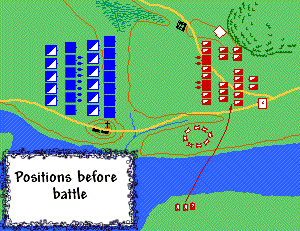
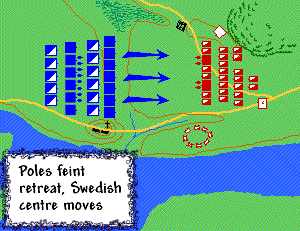 Finally
in the afternoon Hetman ordered his screening arquebusiers to withdraw
suddenly and obviously, in an attempt to give the impression it
was the start of the retreat of the whole army. Charles on seeing
this and fearing this movement of his weaker enemy as a real retreat
ordered his forces to attack. Giving up his caution he resigned
from his intended defend-attack tactic and moved his cavalry to
the wings, so as to provide for more options in attack. Most of
the cavalry he moved to his left wing wanting to push the enemy
against the river Dzwina. As the Swedes made their initial maneuvers
Chodkiewicz, concerned with his army's morale, ordered a group of
camp followers, whom had previously sent North, to reveal themselves.
They moved south towards this main forces in a cloud of dust and
with much noise to give the impression of arriving reinforcements
from Krzysztof Radziwill.
Finally
in the afternoon Hetman ordered his screening arquebusiers to withdraw
suddenly and obviously, in an attempt to give the impression it
was the start of the retreat of the whole army. Charles on seeing
this and fearing this movement of his weaker enemy as a real retreat
ordered his forces to attack. Giving up his caution he resigned
from his intended defend-attack tactic and moved his cavalry to
the wings, so as to provide for more options in attack. Most of
the cavalry he moved to his left wing wanting to push the enemy
against the river Dzwina. As the Swedes made their initial maneuvers
Chodkiewicz, concerned with his army's morale, ordered a group of
camp followers, whom had previously sent North, to reveal themselves.
They moved south towards this main forces in a cloud of dust and
with much noise to give the impression of arriving reinforcements
from Krzysztof Radziwill. 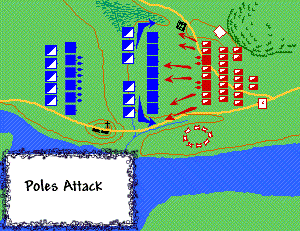 Chodkiewicz
aimed at an outflanking on the left wing so as to force the Swedes
away from the river rather than pushing them against it. This was
the preferred option in order to allow the Polish-Lithuanian horsemen
to take advantage of the drier ground and maximise use of their
best qualities - the impetus - of full gallop charges. The wet meadows
of the old riverbed to the north did not provide the opportunity
of launching a forceful outflanking on that wing, limiting the fighting
to a relatively confined area. Further more the wet meadows did
not pose for the Swedish cavalry the same problems as they did not
use the full gallop charge.
Chodkiewicz
aimed at an outflanking on the left wing so as to force the Swedes
away from the river rather than pushing them against it. This was
the preferred option in order to allow the Polish-Lithuanian horsemen
to take advantage of the drier ground and maximise use of their
best qualities - the impetus - of full gallop charges. The wet meadows
of the old riverbed to the north did not provide the opportunity
of launching a forceful outflanking on that wing, limiting the fighting
to a relatively confined area. Further more the wet meadows did
not pose for the Swedish cavalry the same problems as they did not
use the full gallop charge. 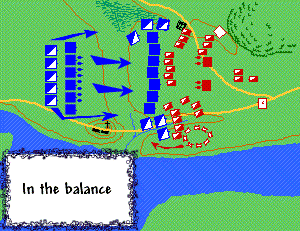 While
the right wing and center were primarily formed of heavy cavalry
(hussars and reiters) best for breaking through enemy formations
in frontal attacks, so the left wing was primarily Cossack cavalry,
so superb at maneuvers on enemy flanks.
While
the right wing and center were primarily formed of heavy cavalry
(hussars and reiters) best for breaking through enemy formations
in frontal attacks, so the left wing was primarily Cossack cavalry,
so superb at maneuvers on enemy flanks. 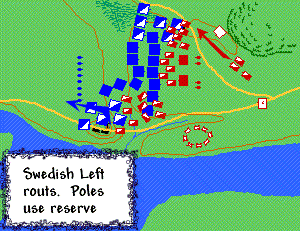 The
retreat of the arquebusiers had lured the Swedish right wing into
the fire of the Polish-Lithuanian Camp. The distracted cavalry was
then attacked frontally by Dabrowa's main forces and at the same
time outflanked by the Tartars and were quickly broken. Cavalry
struck the rear and side of the Swedish right wing tercio who were
busy in battle with the Polish-Lithuanian centre.
The
retreat of the arquebusiers had lured the Swedish right wing into
the fire of the Polish-Lithuanian Camp. The distracted cavalry was
then attacked frontally by Dabrowa's main forces and at the same
time outflanked by the Tartars and were quickly broken. Cavalry
struck the rear and side of the Swedish right wing tercio who were
busy in battle with the Polish-Lithuanian centre. 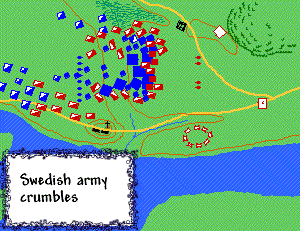 Sapieha
waited, while the wet meadows were passed, where his hussars would
have lost impetus. When the Swedish cavalry moved onto firmer ground,
Sapieha attacked with his first line smashing the enemy and pushed
them onto the wetlands, however the Swedish second line repulsed
the hussars, who had not managed to reform after the chase. When
the Swedes reached the dry ground they were struck by Sapieha's
second line, who then also repulsed Brandt's reorganised first line.
Chodkiewicz seeing the success of Dabrowa and the tying up of the
Swedish centre, and since the Swedes had also engaged all their
forces, decided to use his reserve to outflank them on Sapieha's
wing. Lacki struck the side of Brandt's reiters and crushed them
completely.
Sapieha
waited, while the wet meadows were passed, where his hussars would
have lost impetus. When the Swedish cavalry moved onto firmer ground,
Sapieha attacked with his first line smashing the enemy and pushed
them onto the wetlands, however the Swedish second line repulsed
the hussars, who had not managed to reform after the chase. When
the Swedes reached the dry ground they were struck by Sapieha's
second line, who then also repulsed Brandt's reorganised first line.
Chodkiewicz seeing the success of Dabrowa and the tying up of the
Swedish centre, and since the Swedes had also engaged all their
forces, decided to use his reserve to outflank them on Sapieha's
wing. Lacki struck the side of Brandt's reiters and crushed them
completely. 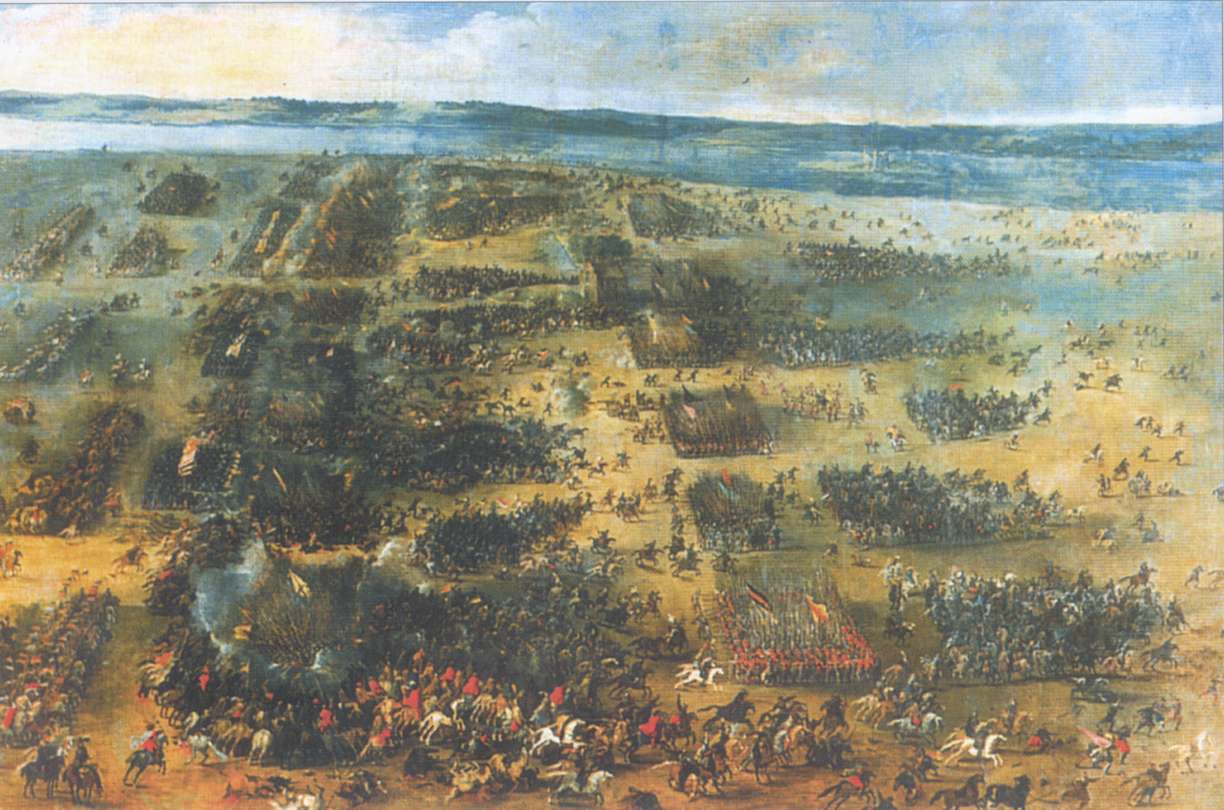


 ... Mehmet did.
... Mehmet did.